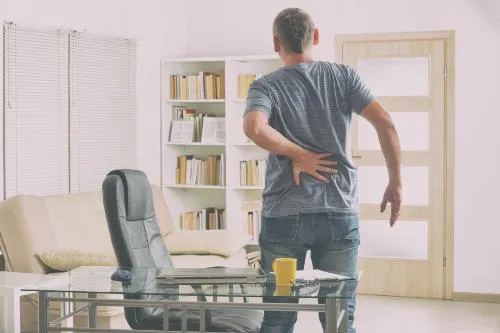
Understanding Low Back Pain: A Brief Guide for Chiropractic Patients
Welcome to our comprehensive guide on low back pain! We understand the impact that low back pain can have on your daily life. That’s one of the main reasons why we do what we do. In this article, we aim to provide you with valuable insights and information about low back pain, its causes, symptoms, treatment options, and prevention strategies. Our team is dedicated to helping you find relief and regain control over your well-being. Let’s dive right in!
What is Low Back Pain?
Low back pain, also known as lumbago, refers to discomfort or pain in the lower part of the back, specifically the area between the bottom rib and the buttocks crease. It is one of the most common musculoskeletal problems experienced by people of all ages. Low back pain can vary in intensity, ranging from a dull ache to sharp, debilitating pain, and can be either acute or chronic in nature.
Causes of Low Back Pain
Understanding the underlying causes of low back pain is crucial for effective treatment and prevention. While there can be various triggers, here are some common factors that contribute to low back pain:
Muscle Strain: Overexertion, improper lifting techniques, or sudden movements can strain the muscles and ligaments in the back, leading to pain and discomfort.
Herniated Disc: A herniated or slipped disc occurs when the soft, jelly-like center of a spinal disc pushes through a crack in the tough outer layer, irritating nearby nerves and causing pain.
Degenerative Disc Disease: As we age, the spinal discs gradually wear down, losing their cushioning effect and causing pain due to bone-on-bone contact.
Spinal Stenosis: This condition involves the narrowing of the spinal canal, which puts pressure on the spinal cord and nerves, leading to pain and other symptoms.
Sciatica: Sciatic nerve compression, often caused by a herniated disc or bone spur, results in radiating pain that travels from the lower back through the buttocks and down one leg.
Symptoms and Diagnosis
Identifying the symptoms associated with low back pain is essential for accurate diagnosis and appropriate treatment. Common symptoms include:
Dull, aching pain: Persistent pain in the lower back region.
Sharp, shooting pain: Intermittent episodes of intense pain that may radiate down the leg.
Limited range of motion: Difficulty bending, lifting, or performing daily activities.
Muscle spasms: Involuntary muscle contractions in the lower back.
Numbness or tingling: Sensations of numbness or tingling in the back, buttocks, or legs.
If you’re experiencing these symptoms, it’s crucial to consult a qualified chiropractor or healthcare professional for an accurate diagnosis. They will conduct a thorough evaluation, which may include a physical examination, medical history review, and possibly diagnostic tests like X-rays or MRI scans.
Chiropractic Treatment for Low Back Pain
Chiropractic care offers a holistic and non-invasive approach to managing and treating low back pain. Chiropractors focus on the relationship between the spine and the nervous system, aiming to restore proper alignment, mobility, and function. Here are some common chiropractic treatments for low back pain:
Spinal Manipulation: Also known as chiropractic adjustment, this technique involves applying controlled force to specific spinal joints to improve alignment, reduce pain, and enhance overall function.
Massage Therapy: Chiropractors may use various massage techniques to relax muscles, alleviate tension, and improve blood circulation in the affected area.
Exercise and Rehabilitation: Customized exercise programs help strengthen the muscles supporting the lower back, improve flexibility, and promote better posture. Your chiropractor will design an exercise plan tailored to your specific needs and condition. These exercises may include:
Core Strengthening: Targeting the muscles of the abdomen, back, and pelvis to provide stability and support to the spine.
Stretching Exercises: Gentle stretching movements to increase flexibility, relieve muscle tension, and improve range of motion.
Low-Impact Aerobic Exercises: Activities like walking, swimming, or cycling that promote cardiovascular health without putting excessive strain on the lower back.
Postural Training: Guidance on maintaining proper posture during daily activities, such as sitting, standing, and lifting, to reduce stress on the lower back.
By incorporating these exercises into your routine, you can enhance the effectiveness of chiropractic treatments and promote long-term healing and pain relief.
Lifestyle Modifications and Self-Care Tips
In addition to chiropractic care and exercise, there are several lifestyle modifications and self-care practices that can help manage and prevent low back pain. Here are some recommendations:
Maintain a Healthy Weight: Excess weight can strain the lower back, so maintaining a healthy weight through a balanced diet and regular exercise is essential.
Practice Good Body Mechanics: When lifting heavy objects, remember to bend at the knees and use your leg muscles instead of straining your back. Avoid twisting motions and distribute weight evenly.
Ergonomic Workstation Setup: If you have a desk job, ensure your workstation is ergonomically designed. Use a chair with proper lumbar support, adjust the height of your desk and computer screen, and take regular breaks to stretch and move.
Use Proper Mattress and Pillow: Invest in a mattress and pillow that provide adequate support for your spine and promote a neutral sleeping position.
Quit Smoking: Smoking reduces blood flow and impairs healing, increasing the risk of back pain. Quitting smoking can have significant benefits for your overall spinal health.
Stress Management: Chronic stress can contribute to muscle tension and exacerbate low back pain. Engage in stress-reducing activities like meditation, deep breathing exercises, or hobbies you enjoy.
Prevention Strategies for Low Back Pain
Preventing low back pain is always better than dealing with it after it occurs. Here are some preventive measures to keep your back healthy:
Regular Exercise: Engage in regular physical activity to keep your back muscles strong, flexible, and well-supported. Include exercises that specifically target the core muscles and promote good posture.
Proper Lifting Techniques: When lifting heavy objects, use your leg muscles, keep the object close to your body, and avoid twisting movements.
Maintain a Healthy Posture: Whether sitting, standing, or walking, maintain proper posture to reduce stress on your spine. Avoid slouching or prolonged periods of sitting or standing.
Warm-Up and Stretch: Before engaging in physical activities or exercise, warm up your muscles with light aerobic activity and perform stretching exercises to prepare your body for the exertion.
Regular Chiropractic Check-Ups: Even if you are not experiencing pain, regular chiropractic check-ups can help identify and address any potential spinal misalignments or imbalances before they develop into more significant issues.
By following these preventive strategies, you can significantly reduce the risk of low back pain and maintain a healthy spine for years to come.
Low back pain can be a challenging condition to live with, but with the right knowledge, treatment, and preventive measures, you can regain control of your life. Our chiropractic team is dedicated to providing top-quality chiropractic care and comprehensive support to help you overcome low back pain.
Through personalized treatment plans, including chiropractic adjustments, exercise programs, and lifestyle guidance, we aim to alleviate your pain, restore your mobility, and improve your overall well-being. We understand the impact that low back pain can have on your daily life, and our goal is to empower you with the knowledge and tools necessary to manage your condition effectively.
Contact us today to schedule an appointment and take the first step towards a pain-free life. Let us help you on your journey to optimal spinal health and a better quality of life.
This article is copyrighted by Blogging Chiropractors for its Doctor of Chiropractic members and may not be copied or duplicated in any manner including printed or electronic media, regardless of whether for a fee or gratis without the prior written permission of Blogging Chiropractors.
Office Hours
Mon 8:00-12:30, 2:30-7pm
Tues 8:00-12:30, 2:30-7pm
Wed 8:00-12:30, 2:30-7pm
Thurs 8:00-12:30, 2:30-7pm
Fri - Sun Closed
© 2025 Gonstead Chiropractic Center - All Rights Reserved

